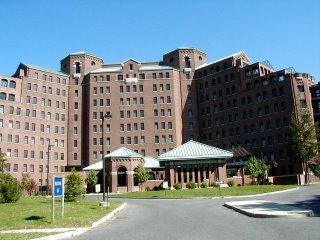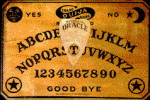
What happens when you mix teens, alcohol, camcorders and abandoned mental asylums ?
CLICK HERE TO FIND OUT
SOME HISTORY OF KINGS PARK,

The Kings Park Psychiatric Center was established in 1885 by what was then the City of Brooklyn, prior to the merging of Brooklyn with Queens, Manhattan, Staten Island, and the Bronx, to form the famous New York City. The official name of the hospital in its first ten years was the "Kings County Asylum," taken from the name of the county that Brooklyn occupied. The hospital was revolutionary at the time in the sense that it was a departure from the asylums of folklore, which were overcrowded places where gross human rights abuses often took place. The asylum, built by Brooklyn to alleviate overcrowding in its own asylums, was a "Farm Colony" asylum, where patients worked in a variety of farm-related activities, such as feeding livestock and growing food, as this was considered to be a form of therapy for the mentally ill at the time.
Eventually, overcrowding became a problem in the Kings County Asylum, the very thing that it was trying to relieve. New York State responded to the problem in 1895, when control of the asylum passed into state hands, and it was subsequently renamed the Kings Park State Hospital. The surrounding community, which had previously been known as "St. Johnland," adopted the name "Kings Park," which it is still known as today. The state eventually built the hospital up into a self-sufficient community that not only grew its own food, but also generated its own heat and electricity, had its own Long Island Rail Road spur, and housed its staff on-site.
As patient populations grew throughout the early part of the 20th century, the hospital itself continued to grow, and by the late 1930s the state began to build upward instead of outward. During this time period, the famous 13-story Building 93 was built. Designed by state architect William E. Haugaard and funded with Works Progress Administration money, the building, often dubbed "the most famous asylum building on Long Island," was completed in 1939 and would be used as an infirmary for the facility's geriatric patients, as well as for patients with chronic physical ailments.
Post-World War II, Kings Park and the other Long Island asylums would see their patient populations soar. In 1954, the patient census at Kings Park topped 9,300, but would begin a steady decline afterwards. By the time Kings Park reached its peak patient population, the old "rest and relaxation" philosophy surrounding farming gave way to pre-frontal lobotomies and electro-shock therapy, but those methods would quickly become ancient in 1955, following the introduction of Thorazine, the first widely used drug in the treatment of mental illness. As medication made it possible for patients to live normal lives outside of a mental institution, the need for large facilities like Kings Park diminished, and the patient population began to drop. By the early 1990s the Kings Park Psychiatric Center, as it had come to be known by that point, was operating as a ghost of its former self, with many buildings being shut down or reduced in usage (including the massive Building 93, by the early 1990s, only the first few floors of the building were in use).
In the early 1990s, with patient populations at increasingly low levels, the New York State Office of Mental Health (formerly the Department of Mental Hygiene) began to plan for the closure of Kings Park as well as another Long Island asylum, the Central Islip Psychiatric Center. The plans called for Kings Park and Central Islip to close, and have any remaining patients from both facilities transferred to Pilgrim Psychiatric Center, which was at one time the world's largest hospital, or be discharged. In the fall of 1996, the plans were implemented, and the few remaining patients from Kings Park and Central Islip were transferred to Pilgrim, ending Kings Park's 111-year run.
SOME HISTORY OF PILGRIM PSYCHIATRIC CENTER

By 1900, overcrowding in city asylums was becoming a major problem that many tried to resolve. One answer was to put the mentally ill to work farming in a relaxing setting on what was then rural Long Island. The new state hospitals were dubbed "Farm Colonies" because of their live-and-work treatment programs, agricultural focus and patient facilities. However, these farm colonies, the Kings Park State Hospital (later known as the Kings Park Psychiatric Center) and the Central Islip State Hospital (later known as the Central Islip Psychiatric Center), quickly became overcrowded, just like the earlier institutions they were supposed to replace.
NY state responded by making plans for a third so-called farm colony, what was to become the Pilgrim State Hospital, named in honor of the former New York State Commissioner of Mental Health, Dr. Charles W. Pilgrim. The state bought up approx. 1,000 acres of land in Brentwood and began construction in 1929. The hospital opened on October 1, 1931 as a close knit community with its own police and fire department, courts, post office, a LIRR station, power plant, potter's field, water tower and houses for doctors, psychiatrists, and asylum administrators. A series of underground tunnels were used for routing steam pipes and other vital utilities.
The hospital would continue to grow as the patient population increased. Eventually, the state of New York bought up more land to the southwest of the facility to construct Edgewood State Hospital, a short-lived stand-alone facility that operated under Pilgrim's umbrella.
During World War II, the War Department took over control of the entire Edgewood facility along with three new buildings at Pilgrim, buildings 81, 82, and 83 (visible from the Long Island Expressway and still used today). The War Department constructed numerous temporary structures and operated Edgewood and buildings 81-83 as "Mason General Hospital," a psychiatric hospital devoted to treating battle-traumatized soldiers. Famed filmmaker John Huston, who received a special commission in the U.S. Army Signal Corps during World War II, made a documentary at Mason called "Let There Be Light" that showed the effects of war on mental health. The film sparked a firestorm of controversy and was not seen by the public until 1981.
After the war, Pilgrim experienced a surge in patient numbers that made it the world's largest hospital, topping out at 13,875 patients in 1954, around this time, the old "rest and relaxation" philosophy gave way to more extreme measures like pre-frontal lobotomies and electro-shock therapy. However, Pilgrim and the other state hospitals began to decline shortly afterwards with the arrival of pharmaceutical alternatives to institutionalization.
Pilgrim is today the last of the state asylums still operating on Long Island. However, it is no longer what it used to be. The farming section of the hospital was sold off, renovated, and became the Western Campus of the Suffolk County Community College in 1974. A large part of the Pilgrim campus was sold to a developer, and numerous abandoned structures on those lands were demolished in recent years, however, rebuilding has not begun. Other abandoned structures, like the former administration building, medical/surgical building, doctor's residences and utilities section remain standing for the time being (those parts of the campus are owned by the developer as well). Only about a third of the original Pilgrim campus is still in operation, though its future is also cloudy.
Pilgrim also hosts a museum on site, which displays items from Kings Park, Central Islip, Pilgrim, and Edgewood such as pictures, old newsletters, relics from abandoned and/or demolished buildings, and other historical information that hint back to a largely forgotten era.
TAGS
movies
Horror
horror movies
















2 comments:
Was there last night. Scary shit. Going back this weekend, when the rent-a-cops aren't suspecting, lol.
i worked at pilgrim for 35 1/2 years.... so many stories i could tell! ....
Post a Comment